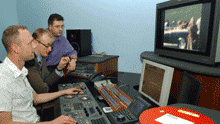Kennedy assassination film being digitally restored


(Pictured left to right) Perry Gibbs (colorist with the post production facility, Home, in London), Christopher O'Hearn (Head of Content Development at APTN) and Mike Smith (Metro Broadcast's Technical Services Manager) restore the Kennedy assassination film using Snell & Wilcox's Archangel archival restoration technology.
One of the most famous news clips in U.S. television history is being digitally restored after 40 years.
Known as the “Muchmore film,” it is one of three main motion pictures of the assassination of President John F. Kennedy in Dallas on November 23, 1963. The United Press International has acquired the footage, taken by Marie Muchmore. It is now part of the extensive Associated Press Television News (APTN) Library.
The restored film, to be released in January 2003, will be available to program producers wishing to use it in the 40th anniversary programming next year pertaining to the Kennedy assassination. APTN has hired Metro Broadcast, a London television facility company, to restore the film using Snell & Wilcox’s Archangel archival restoration technology.
Snell & Wilcox developed the Archangel to digitally stabilize and restore images by removing dirt, scratches, tape tear, film weave and other imperfections in film and video.
Christopher O'Hearn, head of content development at APTN, said the aim of the restoration project is to make the image more watchable. “Are we going to see a second gunman? I doubt it. But if a program maker is using scratched, washed-out images then viewers aren’t going to be giving their full concentration, so we think it is a way of helping to tell the story.”
Muchmore’s footage shows Kennedy’s motorcade turning into Houston Street and captures the final fatal shot to the head. It also shows the mysterious “Babushka Lady” filming just feet away from the President's car. That sensational film has never been retrieved and the woman was never conclusively identified.
The professional video industry's #1 source for news, trends and product and tech information. Sign up below.
Archangel provides comprehensive restoration of damaged footage in real-time, rather than on a frame-by-frame basis. As a result it enables broadcasters and archivists to restore damaged film and video at a more practical cost. APTN’s staff decided to use Archangel after seeing a demonstration at Metro.
Snell & Wilcox developed the Archangel to digitally stabilize and restore images by removing dirt, scratches, tape tear, film weave and other imperfections in film and video.
Mike Smith, Metro's technical services manager who is overseeing the restoration, said care of the film will be the main consideration. “Obviously with a film like this it is essential to make sure that nothing is lost or changed. Archangel allows us to make a very precise restoration so the picture ends up being clearer and cleaner, but it is still the same image.”
Archangel is targeted to broadcasters and video libraries that need to cost-effectively restore vintage video and film for contemporary programs.
The restored Kennedy film will be released at the NATPE (National Association of Television Program Executives) trade show in New Orleans, on January 20, 2003. It will be available for ordering and licensing from APTN. Special orders such as up-conversion to high-definition formats will be available through Metro.
For more information contact: APTN, Christopher O'Hearn, cohearn@ap.org; Metro, info@metrobroadcast.com; and Snell & Wilcox, David Cunningham, david.cunningham@snellwilcox.com.
